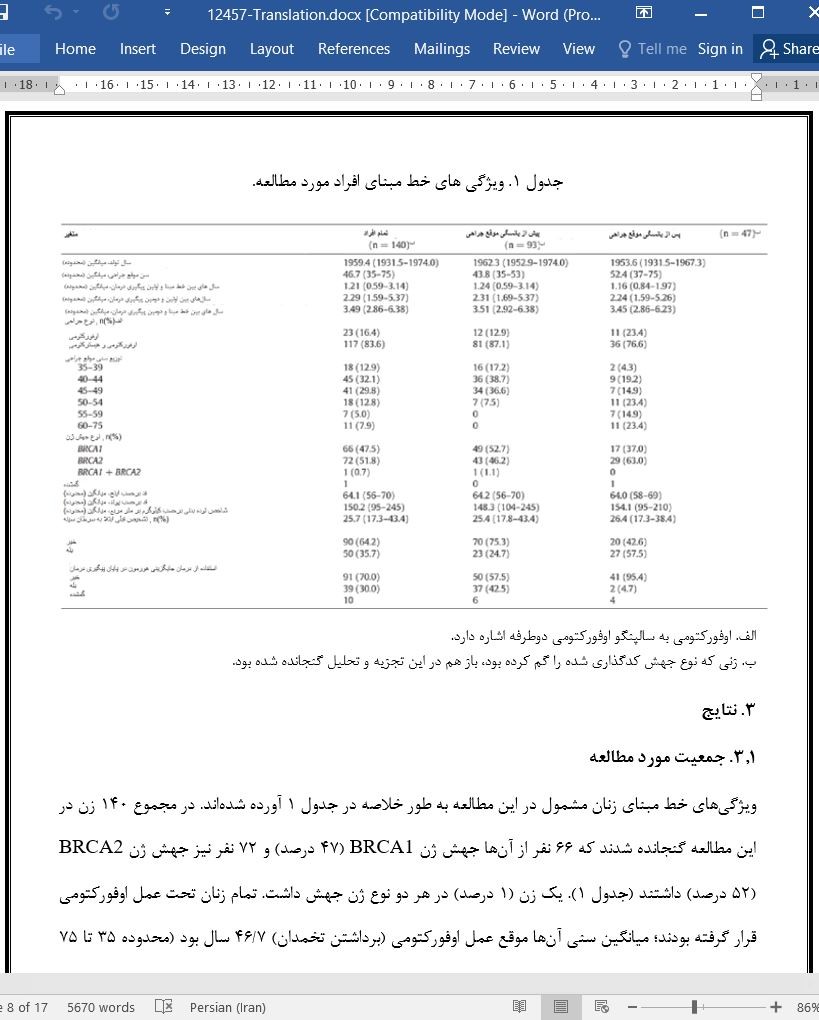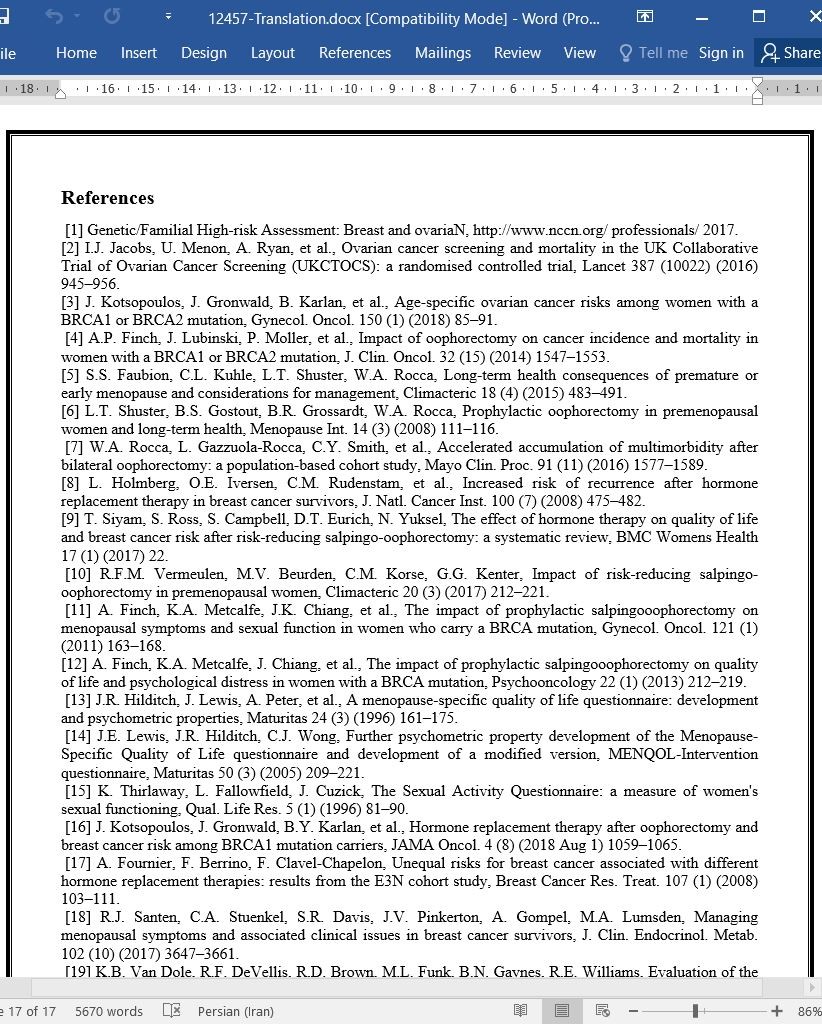
دانلود مقاله اثرات عمل سالپنگو اوفورکتومی بر علائم یائسگی و عملکرد جنسی در میان زنان دارای جهش ژن BRCA1 یا BRCA2
چکیده
مقدمه: عمل جراحی برداشتن لوله های رحم و تخمدان یا سالپنگو اوفورکتومی (Salpingo-oophorectomy) دوطرفه پیشگیرانه (BSO) به افراد حامل جهش ژن BRCA در سنین پایین توصیه میشود تا از ابتلا به سرطان تخمدان جلوگیری شود. این مطالعه نقش تعیین کنندهای در ارزیابی تأثیر عمل سالپنگو اوفورکتومی دوطرفه پیشگیرانه بر پیامدهای غیر سرطانی از جمله کیفیت زندگی (QOL)، علائم یائسگی و عملکرد جنسی دارد.
روشها: افراد حامل جهش ژن BRCA که تصمیم گرفتند تحت عمل سالپنگو اوفورکتومی دوطرفه پیشگیرانه قرار بگیرند، سه پرسشنامه را قبل از جراحی و سپس مجدداً یک و سه سال پس از جراحی بعدی پر کردند. این پرسشنامه ها عبارت بودند از: 1) پرسشنامه سابقه درمانی، 2) پرسشنامه مداخله کیفیت زندگی ناشی از یائسگی و 3) پرسشنامه فعالیت جنسی. تغییر کیفیت زندگی، علائم یائسگی و عملکرد جنسی قبل و بعد از عمل اوفورکتومی با کمک آزمون تی (t-test) زوجی مشخص شده و براساس وضعیت یائسگی در موقع جراحی طبقه بندی شدند.
نتایج: 140 فرد حامل جهش ژن BRCA را در بررسی منظور کردیم که پس از انجام عمل سالپنگو اوفورکتومی دوطرفه پیشگیرانه به طور میانگین 5/3 سال پیگیر درمان خود بودند. در میان 93 زنی که در دوران پیش از یائسگی بودند، اوفورکتومی یا همان عمل برداشتن تخمدان با افزایش علائم یائسگی (وازوموتور یا اعصاب تنگ و گشاد کننده رگها، جسمانی) (001/0>P ) و کاهش عملکرد جنسی (ناراحتی، لذت) (0001/0≥ P) همراه بود، اما تأثیری بر کل کیفیت زندگی (31/0= P) نداشت. با استفاده از روش درمان جایگزینی هورمون (HRT) اثرات نامطلوب آن کاهش یافت ولی به طور کامل برطرف نشد. زنانی که موقع جراحی در دوران پس از یائسگی بودند (47= n)، با افزایش علائم جسمی (03/0= P) و کاهش عملکرد جنسی (ناراحتی) (004/0= P) و کیفیت کلی زندگی (04/0= P) مواجه شدند.
نتیجه گیری: نتایج پژوهش حاضر نشانگر این است که افراد حامل جهش ژن BRCA 5/3 سال پس از عمل اوفورکتومی با وخامت معناداری در علائم یائسگی و کاهش عملکرد جنسی مواجه شدند؛ به ویژه در میان افرادی که قبل از یائسگی طبیعی تحت عمل جراحی قرار گرفته بودند. استفاده از روش درمان جایگزینی هورمون باعث کاهش بعضی از عوارض آن و نه همه گردید. در کل، زنانی که موقع جراحی در دوران پیش از یائسگی بودند، با کاهش کیفیت زندگی خود مواجه نشدند.
1.مقدمه
زنان دارای جهش ژن BRCA1 یا BRCA2 که با خطر بالای ابتلا به سرطان تخمدان در طول زندگی خود مواجهاند، انجام عمل سالپنگو اوفورکتومی دوطرفه پیشگیرانه (BSO) (از اینجا به بعد اوفورکتومی مینامیم) پیش از یائسگی توصیه می شود [1]. قابل اعتماد بودن غربالگری سرطان تخمدان در زنان با خطر بالا در تحقیقات اثبات نشده است و در حال حاضر کاهش خطر جراحی مؤثرترین راه حل به حساب میآید [2]. در وضعیت کنونی، انجام عمل اوفورکتومی برای افراد حامل جهش ژن BRCA2 بین 35 تا 40 سال و افراد حامل جهش ژن BRCA2 بین 40 تا 45 سال توصیه می شود [1، 3]. عمل اوفورکتومی سبب کاهش خطر ابتلا به سرطان تخمدان و همین طور تمام مرگ و میرهای ناشی از آن می شود [4].
4.بحث
در این مطالعه آیندهنگر، ۱۴۰ زن با یک نوع جهش BRCA1 یا BRCA2 و میانگین پیگیری درمان 5/3 ساله پس از عمل اوفورکتومی گنجانده شدند. در میان ۹۳ زنی که در دوران پیش از یائسگی بودند و به تبع با یائسگی ناشی از جراحی مواجه شدند، شاهد هیچ کاهشی در کیفیت کلی زندگی پس از جراحی نبودیم، اما در حوزه های خاصی با کاهش مواجه بودیم. از این گذشته، وخامت معناداری در علائم وازوموتور، جسمی و جنسی مشاهده شد. در این حوزهها، سطوح پس از جراحی مشابه با سطوحی بود که زنان دوران پس از یائسگی موقع جراحی با آن مواجه شده بودند. به طور متوسط، تعداد علائم در میان افراد استفاده کننده از درمان جایگزینی هورمون نسبت به سایر افراد کمتر بود، اما استفاده از این روش درمانی باعث رفع تمام علائم نگردید. زنانی که موقع جراحی در دوران پس از یائسگی بودند، با کاهش قابلتوجهی در کیفیت کلی زندگی و علائم جسمی روبرو شدند؛ با این حال، وسعت تغییر کوچک بود.
Abstract
Introduction Prophylactic bilateral salpingo-oophorectomy (BSO) is recommended at an early age to BRCA mutation carriers to prevent ovarian cancer. It is critical to evaluate the impact of BSO on non-cancer outcomes, including quality of life (QOL), menopausal symptoms and sexual functioning.
Methods BRCA mutation carriers who elected to undergo a BSO completed three questionnaires prior to surgery and then again approximately one and three years following surgery which included: 1) medical history questionnaire, 2) Menopause-Specific Quality of Life Intervention questionnaire and 3) Sexual Activity Questionnaire. The change in quality of life, menopausal symptoms and sexual functioning before and after oophorectomy was determined using a paired t-test and stratified by menopausal status at surgery.
Results We included 140 BRCA mutation carriers with an average follow-up of 3.5 years following BSO. Among 93 women who were premenopausal, oophorectomy was associated with an increase in menopausal symptoms (vasomotor, physical) (P < 0.001) and a decline in sexual functioning (discomfort, pleasure) (P ≤ 0.0001), but had no impact on overall QOL (P = 0.31). HRT mitigated, but did not eliminate the adverse effects. Women who were postmenopausal at surgery (n = 47) experienced an increase in physical symptoms (P = 0.03) and a decline in sexual functioning (discomfort) (P = 0.004) and in overall QOL (P = 0.04).
Conclusions This study demonstrates that 3.5 years after oophorectomy, BRCA mutation carriers experience a significant worsening of menopausal symptoms and a decline in sexual functioning, particularly among those who underwent surgery prior to natural menopause. The use of HRT mitigated some but not all the effects. Overall, women who were premenopausal at surgery did not experience a decline in their QOL.
1. Introduction
Women with a BRCA1 or BRCA2 mutation face a high lifetime risk of developing ovarian cancer and preventive bilateral salpingooophorectomy (BSO) (referred to as oophorectomy hereafter) is recommended prior to menopause [1]. Screening for ovarian cancer in highrisk women has not been shown to be reliable and currently surgical risk reduction is the most effective option [2]. Oophorectomy is currently recommended between the ages of 35 and 40 for BRCA1 mutation carriers and between 40 and 45 for BRCA2 mutation carriers [1,3]. Oophorectomy reduces the risk of developing ovarian cancer as well as all-cause mortality [4].
4. Discussion
This prospective study included 140 women with a BRCA1 or BRCA2 mutation and a mean follow-up of 3.5 years following preventive oophorectomy. Among the 93 women who were premenopausal, and thus experienced surgical menopause, we observed no decline in overall quality of life post-surgery, but there were declines in specific domains. There was a significant worsening in vasomotor, physical and sexual symptoms. For these domains, post-surgical levels were similar to those experienced by women who were postmenopausal at surgery. On average, symptoms were fewer among HRT users than non-users, but HRT use did not eliminate all the symptoms. Women who were postmenopausal at surgery experienced a significant decline in overall quality of life and physical symptoms; however, the magnitude of change was small.
Year of birth, mean (range)
Age at surgery, mean (range)
Years between baseline and first follow-up, mean (range)
Years between first and second follow-up, mean (range)
Years between baseline and second follow-up, mean (range)
Surgery type, n (%)
Age distribution at surgery, n (%)
Mutation type, n (%)
Height in inches, mean (range)
Weight in pounds, mean (range)
Body mass index in kg/m2, mean (range)
Previous breast cancer diagnosis, n (%)
HRT use at the end of follow-up
چکیده
1.مقدمه
2.مواد و روش ها
2.1. جمعیت مورد مطالعه
2.2 جمعآوری دادهها
2.3.انتخاب موضوع
2.4. تجزیه و تحلیل آماری
3. نتایج
3.1. جمعیت مورد مطالعه
3.2. کیفیت زندگی
3.3. سلامت جنسی
4.بحث
منابع
Abstract
1. Introduction
2. Materials and methods
2.1. Study population
2.2. Data collection
2.3. Subject selection
2.4. Statistical analysis
3. Results
3.1. Study population
3.2. Quality of life
3.3. Sexual health
4. Discussion
References
- اصل مقاله انگلیسی با فرمت ورد (word) با قابلیت ویرایش
- ترجمه فارسی مقاله با فرمت ورد (word) با قابلیت ویرایش، بدون آرم سایت ای ترجمه
- ترجمه فارسی مقاله با فرمت pdf، بدون آرم سایت ای ترجمه



